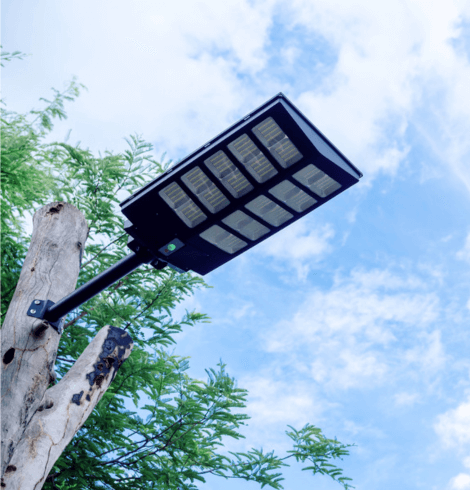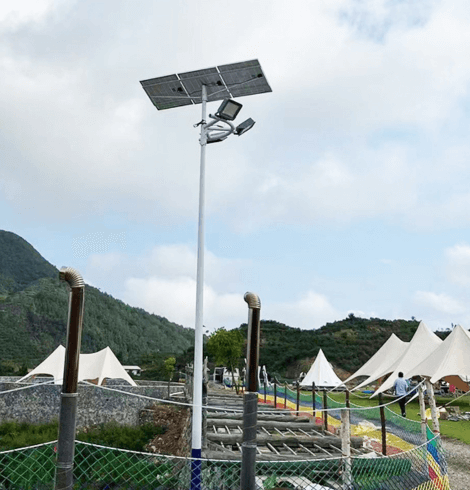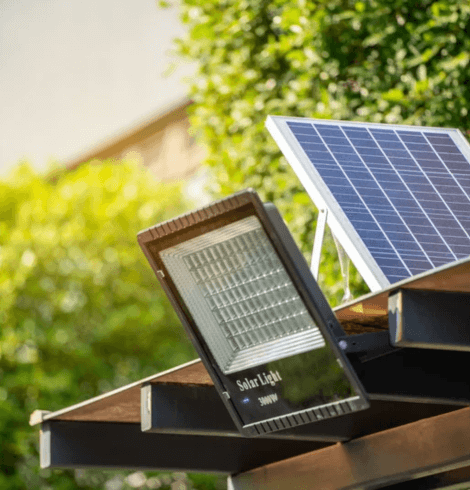Lumens tell you how bright a solar light will actually be. If you want a solar light that truly lights up your garden, street, or security area, you must look at the lumens—not watts. Watts only measure power usage, while lumens show how much visible light the fixture emits. More lumens mean a brighter light.
For example, pathway lights typically need 50-200 lumens, while solar street lights may require 2000-10,000 lumens depending on the application.
Table of Contents
ToggleIntroduction to Lumens and Solar Light Brightness
When you think of solar lights, the first number that might catch your eye is “watts.” For years, we’ve used watts to decide how bright a bulb is—60W, 100W, the bigger the number, the brighter the bulb.
But here’s the catch: watts measure power consumption, not brightness. In the world of LEDs and solar lights, this old rule no longer applies. Now, if you want to know how bright your light will actually be, there’s one word you need to understand: lumens.
What Are Lumens and Why They Matter in Solar Lighting

Lumens measure the total amount of visible light a light source emits. It’s like counting how much light comes out of a lamp. The more lumens, the brighter the light appears to your eyes. Simple, right? But why does this matter for solar lighting?
Because solar lights rely on energy from the sun, which means every bit of efficiency counts. If you pick a solar light with low lumens, it might look pretty but won’t light up your garden path. On the other hand, a solar light with high lumens will give you the brightness you need without wasting energy.
With that in mind, let’s uncover why watts, though familiar, no longer tell you the full brightness story.
Why Watts Don’t Reflect Brightness in Solar Lighting
Back in the incandescent days, watts were a rough guide to brightness because more power meant more light. A 100W bulb was indeed brighter than a 60W bulb. But with LEDs and solar lighting, wattage measures how much power is consumed, not how much light is produced.
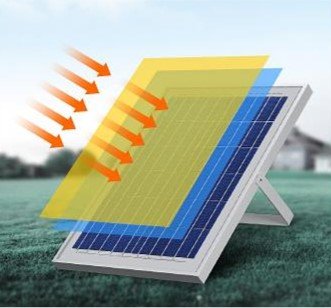
Two different solar lights might both consume 5 watts, but one could emit 500 lumens while another gives off 800 lumens. The difference? Efficiency. Better LED technology squeezes more light from the same amount of power.
In solar lighting, this matters even more because the power budget is limited. You’re working with stored sunlight in a battery. So you want the most lumens for every watt of energy used. That’s why smart solar lighting buyers always look at lumens first. They know watts won’t tell them how bright a light will be.
Now that we’ve clarified the watt-lumen confusion, let’s move to another essential lighting metric—lux—and understand how it works with lumens.
Lumens vs Lux: Understanding Brightness vs Ground Illumination
At this point, you might wonder: if lumens tell me brightness, why do people talk about lux? Here’s the distinction. Lumens measure the total light output of a fixture—how much light it sends out in all directions. Lux, on the other hand, measures how much of that light actually lands on a surface, like the ground, a wall, or a table.

Think of lumens as how much water comes out of a hose. Lux is how wet the ground gets in a certain spot. If you spray water everywhere, you’ll get a wide but shallow puddle (low lux). Focus the hose on one area, and you’ll have a deep puddle (high lux). Similarly, a light can have high lumens but low lux if the beam spreads out too much.
For tasks like pathway lighting or security lighting, lux matters because it tells you whether the light is actually useful on the ground where people walk or where security cameras need clarity.
Once you grasp the difference, the next step is to understand how many lumens are considered ideal for different solar lighting scenarios.
Typical Lumen Ranges for Solar Lighting Applications
Now let’s get practical. How many lumens do you really need for your solar lighting project? It depends on the application.
A decorative solar garden light that adds a gentle glow doesn’t need to be bright—5 to 50 lumens is common. For pathway lights that ensure you won’t trip in the dark, you’ll want around 50 to 200 lumens. Porch lights and wall lanterns usually range from 50 to 150 lumens, giving enough light to see steps and find your keys.
| Application | Typical Lumens | Purpose |
| Garden Accent Lights | 5 – 50 lumens | Decorative glow, ambiance only |
| Pathway Lights | 50 – 200 lumens | Safe walkway lighting |
| Wall Lights (Porch) | 50 – 150 lumens | Entry lighting, steps, doors |
| Motion Security Lights | 300 – 700 lumens | Bright burst for safety, deterrence |
| Floodlights | 700 – 1500 lumens | Broad area lighting, security zones |
| Street Lights | 2000 – 10,000 lumens | Roads, parking lots, large spaces |
When it comes to security lights, the lumen count jumps. Motion-activated wall lights can deliver 300 to 700 lumens when triggered, enough to illuminate an entryway and deter intruders. Solar flood lights and high-output security lights might provide 700 to 1500 lumens or more to cover larger areas.
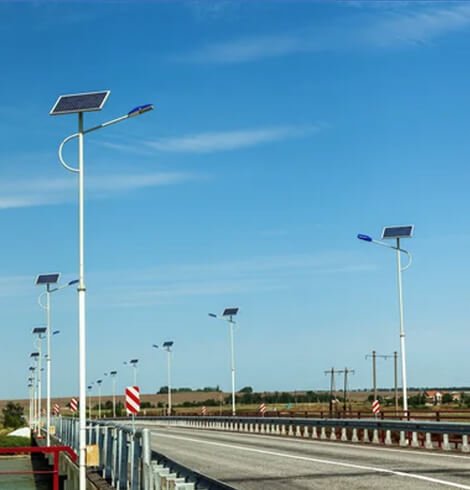
For solar street lights that need to light up roads or parking lots, you’re looking at 2000 lumens for small roads, up to 10,000 lumens for highways and large zones.
But choosing a lumen number isn’t just about picking from a chart. You need to evaluate what’s right for your specific project needs. Here’s how you can make that decision.
Evaluating Lumen Requirements for Your Solar Lighting Project
Choosing the right lumen output isn’t about picking the biggest number. It’s about matching the light to your needs. Start by asking what you want to achieve. If it’s ambiance in a garden, low lumens are fine. For safety on walkways, you’ll need more.
Then consider the size of the area and the mounting height of the light. A light placed at ground level can do its job with fewer lumens than one mounted 15 feet high.
B2B buyers and project managers often go a step further. They look at illuminance (lux) targets based on standards—for example, roads might require 10 to 20 lux on the surface. From there, they calculate how many lumens each fixture needs, considering how far apart the lights will be and how well the fixture distributes light.

Another key is efficiency, known as lumens per watt. In solar lighting, every watt saved extends battery life. Top-tier solar lights boast over 120 lumens per watt, which allows them to deliver powerful lighting without draining energy reserves. If you’re evaluating a solar light for a large area, check if the product provides photometric data or IES files. These show exactly how light will spread and what the ground-level lux will be.
With all this in mind, you’re probably wondering if there are standard benchmarks that help ensure you’re getting quality lighting. Let’s look at how the industry measures up.
Industry Standards and Benchmarks for Lumen Performance
Professional solar lighting isn’t just about raw lumen numbers. There are standards and benchmarks that ensure lights perform as expected. For instance, the Illuminating Engineering Society (IES) sets recommended lux levels for different applications—like 5-10 lux for pathways and up to 20 lux for busy pedestrian areas. Buyers also look at luminous efficacy; high-quality fixtures provide 130-150 lumens per watt.
Another important factor is lumen maintenance, which reflects how well a light maintains its brightness over time. A good fixture will still output 70% to 90% of its original lumens after 50,000 hours of use. B2B buyers may request LM-79 reports (which verify lumen output and distribution) and LM-80 reports (which show LED lifespan performance). These standards ensure that the lumens promised by a manufacturer are delivered consistently.

Now that we’ve walked through the technicals and standards, you’re equipped with the knowledge to make confident lighting decisions.
Conclusion: Lumens Are the True Brightness Metric in Solar Lighting
In solar lighting, lumens are the true measure of brightness. They give you a clear, quantifiable way to know how bright a light will be. Watts no longer serve as a reliable brightness indicator in the LED era.
Understanding how lumens translate into lux helps you make better lighting choices, whether you’re lighting up a garden path or a city street. By matching lumen output to your application and paying attention to efficiency and industry standards, you ensure your solar lighting does exactly what you need it to do—brighten spaces reliably, sustainably, and beautifully.
FAQ
How many lumens do I need for solar pathway lights?
For pathways, 50 to 100 lumens per fixture is usually enough for safe, pleasant illumination. If you want a brighter walkway, go up to 150-200 lumens.
Is 1000 lumens bright enough for a security light?
Yes. For most home security purposes, 1000 lumens is sufficient to light up driveways, backyards, or entrances. Larger commercial spaces might need higher outputs.
Do higher watt solar panels mean brighter lights?
Not necessarily. Watts measure power consumption, not light output. The key is how many lumens the fixture produces per watt consumed. Always check lumen ratings.
What’s the difference between lumens and lux in real-life use?
Lumens tell you how bright a lamp is overall. Lux tells you how bright a surface will be when lit by that lamp. Both are important, but for purchasing lights, lumens are the number you’ll see.
How can I verify a solar light’s lumen claims are accurate?
Look for LM-79 test reports or buy from reputable brands that publish photometric data. If a product seems to promise unrealistic brightness from a tiny solar panel, be cautious.








